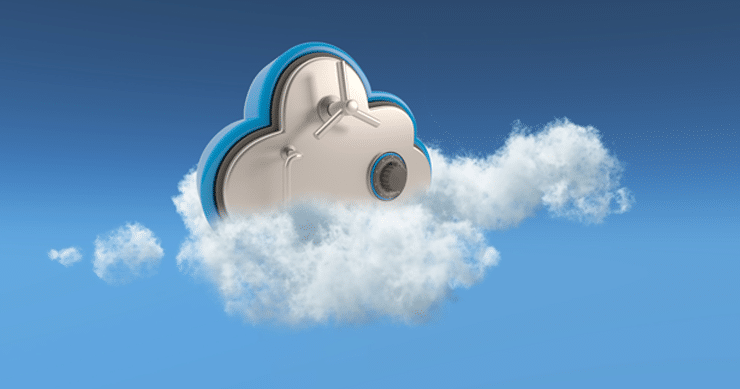In the digital era, cloud computing has become synonymous with agility and scalability for businesses and individuals. However, critical security risks and threats inherent in cloud environments come alongside the myriad benefits. This blog aims to dissect the nuances of cloud security risks, shedding light on the challenges commonly faced when securing digital assets in the cloud.

Who’s Responsible for Security in the Cloud?
Before delving into the specific risks associated with cloud security, it’s crucial to understand the foundational concept of the Shared Responsibility Model. This model represents a new approach to securing cloud environments. Unlike traditional on-premise solutions, with the Shared Responsibility Model, cloud security is a collaborative effort between cloud service providers (CSPs) and their users.
The Shared Responsibility Model defines the division of responsibilities between the CSP (cloud service provider) and the user. The CSP secures the underlying infrastructure, including the physical data centers, networking, and hypervisors. On the other hand, users are entrusted with securing their data, applications, and configurations within the cloud.
This balanced approach ensures that neither party bears the entire burden of cloud security, fostering a cooperative relationship that leverages the expertise of both CSPs and users. The model shifts based on the type of cloud service – Infrastructure as a Service (IaaS), Platform as a Service (PaaS), or Software as a Service (SaaS).
The development of this model was necessitated by the dynamic nature of cloud computing, where traditional security models became inadequate. Oversight of the Shared Responsibility Model is a shared endeavor, with constant communication and collaboration required to adapt to evolving threats and technological advancements.
Understanding this model is fundamental to comprehending the subsequent discussion on security risks in cloud computing. It lays the groundwork for organizations to make informed decisions, implement effective security measures, and navigate compliance complexities in the cloud.
Now, let’s delve into the specific risks associated with cloud security.
Cloud Security Risks
- Misconfigurations
Cloud environments, known for their intricate configurations through web-based interfaces or Infrastructure as Code (IaC), are susceptible to misconfigurations. Cloud resources’ dynamic and scalable nature introduces challenges, making it crucial for teams to adapt and effectively manage configurations. This includes addressing risks such as Broken Object Level Authorization (OWASP API1) and Security Misconfigurations (OWASP API8), where improper configurations may lead to unauthorized access or vulnerabilities.
- Insufficient Access Controls
Cloud platforms offer diverse services, each demanding specific access controls. The scalability of cloud environments complicates the consistent management of access permissions. Teams must navigate complex IAM settings unique to each cloud provider. This challenge aligns with risks such as Broken Authentication (OWASP API2) and Broken Function Level Authorization (OWASP API5), where weak authentication mechanisms or flawed access controls can result in unauthorized access.
- Lack of Encryption
Cloud computing involves data transmission over networks and storage in shared infrastructures. Encryption is vital due to the distributed and multi-tenant nature of cloud services. Teams must implement encryption measures compatible with cloud environments to protect data across various states. This aligns with risks such as Broken Object Property Level Authorization (OWASP API3), emphasizing the importance of encryption at the object property level.
- Incomplete Monitoring and Logging
Cloud environments consist of numerous interconnected components, making monitoring and logging complex. Cloud storage security risks such as incomplete monitoring may lead to the oversight of critical security events.Specialized tools are required to track activities across virtual machines, containers, and cloud services. Incomplete monitoring may lead to the oversight of critical security events. This challenge corresponds to risks like Improper Inventory Management (OWASP API9), highlighting the need for comprehensive monitoring.
- Inadequate Patch Management
Cloud service providers regularly update their platforms, requiring teams to manage patches for virtual machines, containers, and other services. The dynamic nature of cloud infrastructure demands agile patch management to address vulnerabilities promptly. This aligns with risks such as Unrestricted Resource Consumption (OWASP API4), where successful attacks can lead to resource exhaustion or denial of service.
- Limited Disaster Recovery Planning
Cloud environments are susceptible to various disruptions, necessitating effective disaster recovery plans. These plans should align with cloud services, including backup strategies and the ability to restore operations cloud-natively. This challenge relates to risks such as Unrestricted Access to Sensitive Business Flows (OWASP API6), emphasizing the importance of planning for potential disruptions.
- Insecure APIs and Integrations
Cloud Specificity: Cloud computing relies heavily on APIs for seamless service integration. Insecure APIs pose a specific threat in cloud environments, where integration is essential. Teams must be vigilant in securing APIs and verifying the security practices of third-party services. This corresponds to risks such as Unsafe Consumption of APIs (OWASP API10), underlining the importance of secure API practices in cloud-based services.
APIs: The Epicenter of Cloud Security Concerns
At the heart of these security challenges lies the application programming interfaces (APIs), pivotal components that facilitate seamless connections between software without needing human login. APIs, however, present a unique set of challenges. Whether dealing with open-source or proprietary software, the API landscape demands a meticulous approach to identify and address potential risks.
The OWASP API Security Top 10 offers a comprehensive list of common issues associated with APIs, ranging from broken object-level authorization to the unsafe consumption of APIs. This framework underscores the tendency to place unwavering trust in API functionality, often overlooking inherent vulnerabilities. Notably, the list highlights the need for organizations to scrutinize API usage, considering additional technologies that can augment protection, especially for services intended for a wider audience.
As the cloud security landscape evolves, understanding APIs’ critical role in vulnerabilities and solutions becomes paramount. By acknowledging the challenges and proactively implementing robust security measures, organizations can fortify their cloud infrastructure against potential threats, ensuring a resilient and protected digital ecosystem.
Start Getting Value With
Centraleyes for Free
See for yourself how the Centraleyes platform exceeds anything an old GRC
system does and eliminates the need for manual processes and spreadsheets
to give you immediate value and run a full risk assessment in less than 30 days
Real-Life Example of API Risk
The cloud landscape faced challenges as Microsoft grappled with authentication issues, drawing attention from attackers and security experts, including Tenable. The heart of the matter lay in insufficient access control to Azure Function hosts, a critical component of Microsoft’s Power Platform (Power Apps, Power Automation). This revelation underscored the importance of transparency in cloud security, emphasizing the need for robust measures to secure cloud authentication.
Tenable CEO Amit Yoran described the vulnerability allowed attackers to interact with Azure Functions without authentication, exploiting a flaw in creating and operating custom connectors within the Power Platform. This scenario exposed a potential risk wherein attackers could traverse different customer connectors by determining hostnames, posing a serious threat to data integrity.
Microsoft swiftly addressed the Power Platform Custom Code information disclosure vulnerability, as detailed in a technical note. Affected customers were promptly notified via Microsoft 365 Admin Center, ensuring a proactive approach to risk mitigation.
Cloud Security Pain Points and Tips for Improvement
Remote Access and Smart Home Security Challenges
Recent challenges, such as the unprepared shift to remote work and smart home security concerns, have introduced new dimensions to cloud security.
The rapid adoption of remote work infrastructure requires secure frameworks and comprehensive policies to mitigate risks. Organizations should prioritize endpoint security, enforcing the use of virtual private networks (VPNs) and regularly updating security protocols on remote devices.
Smart home devices, previously non-networked, now serve as potential breach points, emphasizing the need for user awareness and safe configuration practices. Employee education programs should include guidelines on securing home networks, updating router passwords, and ensuring the security of connected devices.
Cloud Configuration and BYOD Policies
Cloud configuration should prioritize security over speed. Rushed setups often result in misconfigurations that expose sensitive data. Organizations should allocate sufficient time for detailed cloud security risk assessment, including comprehensive stress testing to identify potential weak points. Continuous monitoring and automated configuration management tools contribute to ongoing security.
BYOD policies demand careful consideration of potential risks. While the flexibility of BYOD policies enhances employee convenience, organizations should implement strict security measures. This includes regularly updating security software on employee devices, conducting periodic security training, and implementing mobile device management (MDM) solutions.
Social Engineering and Cyberattacks
Phishing attacks and social engineering methods continue exploiting technical and human vulnerabilities.
Implementing multi-factor authentication, security software, and regular training are essential measures.
Phishing attacks often target the human security element, relying on unsuspecting users to divulge sensitive information. Organizations should conduct regular and simulated phishing exercises to enhance employee awareness. Multi-factor authentication (MFA) adds an extra layer of protection, requiring additional verification beyond passwords.
Regular training sessions on recognizing social engineering tactics and ongoing communication about emerging threats contribute to a vigilant and security-conscious workforce. Additionally, organizations should invest in advanced email filtering solutions to detect and block phishing attempts before reaching employee inboxes.
How to Secure Data in the Cloud
A. Data Encryption
Use VPN services for private and anonymous data transit.
Identify and encrypt sensitive data, ensuring secure storage of encryption keys.
While VPN services provide secure transit for data, organizations should also focus on encrypting data at rest. This involves identifying and classifying sensitive data, applying encryption algorithms, and securely storing encryption keys. Regularly updating encryption protocols in response to evolving threats enhances the overall security posture.
B. BYOD Security Measures
Encourage end-to-end encryption and regularly update security measures on local devices.
Implement cloud security solutions, such as Kaspersky Hybrid Cloud Security, for comprehensive protection.
End-to-end encryption ensures that data remains secure from the origin device to its destination. This practice safeguards sensitive information even if intercepted during transit. Organizations should promote the use of applications and services that prioritize end-to-end encryption.
Cloud security solutions, such as Kaspersky Hybrid Cloud Security, provide a holistic approach to protecting cloud environments. These solutions offer threat detection, vulnerability management, and real-time monitoring. Regularly updating and configuring these solutions according to evolving threats enhances their effectiveness.
C. Implement multi-factor authentication and avoid unnecessary document downloads
Secure smart home devices, use VPNs for remote work, and regularly update software for increased security.
Test cloud security setups and conduct regular audits to identify and address vulnerabilities proactively.
Multi-factor authentication adds an extra layer of security beyond passwords. Organizations should prioritize its implementation across cloud services, ensuring user access requires multiple verification forms.
Securing smart home devices involves more than just individual device security. Organizations should guide employees on securing their home networks, using VPNs for remote work, and updating router passwords. This comprehensive approach extends the organization’s security perimeter to include employee home environments.
Regularly updating software is a fundamental yet often overlooked aspect of cloud security. Organizations should implement automated patch management systems to ensure that all software, including operating systems and applications, is up-to-date. Conducting regular security audits helps identify potential vulnerabilities and weaknesses that attackers may exploit.
Effectively securing the cloud requires a dual focus on understanding and mitigating security risks and threats. By embracing the shared responsibility model, navigating security and compliance in cloud computing challenges, and implementing proactive measures against potential threats, organizations can confidently harness the power of cloud computing risk while safeguarding their digital assets. In this ever-evolving landscape, a comprehensive and strategic approach to cloud security is key to a resilient and protected digital infrastructure. Stay vigilant, stay secure.
Start Getting Value With
Centraleyes for Free
See for yourself how the Centraleyes platform exceeds anything an old GRC
system does and eliminates the need for manual processes and spreadsheets
to give you immediate value and run a full risk assessment in less than 30 days






